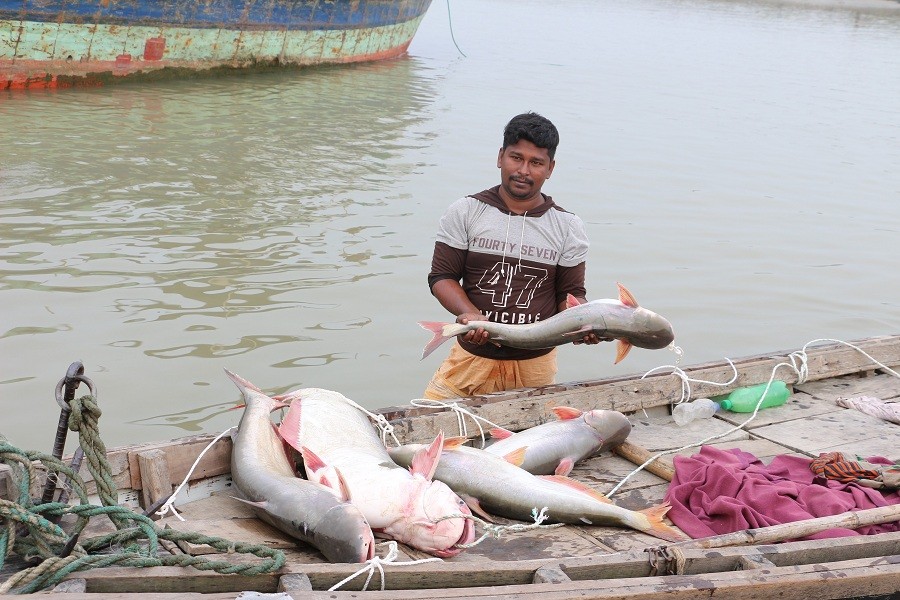Gone are those days when imagining any social or religious festival without satiating your taste buds with sumptuous curries made with freshwater fishes such as pangas, catla, sheat fish, rohu, mrigel, chital, baghair was almost impossible. The availability and abundance of freshwater fishes now seems like a whimsy. Even at the end of the last century, there was no shortage of river fish.
At that time, catching a large fish was no surprise. However, time has changed and so has the source of fish. At present we know large fishes like rohu, katla, mrigel and pangas are cultivated in ponds.
But this year a new ray of hope is gleaming about the availability of large-size fresh water pangas. According to the news reports, large pangas has been caught in the river in different parts of the country for the last few days, especially in the Rajbari, Rajshahi and Shariatpur sections of the Padma River.
A 30-year-old fisherman from Haloishar in Shariatpur's Naria, Hanif caught 86 pangas during the night on November 8. He sold all those fishes in the local fish market for Tk 425,000. Hanif went on to say that he had been fishing since he was a child, but he had never seen such abundance of pangas.
The number of pangas in the river is much higher this year than last year. The average weight of the caught pangas is 5 to 15 kg. Many fishermen have been able to catch about 50-60 pangas a day.
What caused the decrease in the stock of pangas?
According to the Fisheries Act, catching pangas below 12 inches (30 cm) is prohibited. Not obeying the law by fishing with chai, a bamboo-made trap, in which pangas fry get caught in droves, had partly led to the decreasing of the fish in the country.
Excessive use of pesticides and fertilisers, dumping of industrial waste in rivers and seas, and plastic pollution had also caused the decrease of the pangas fish.
Occupation of rivers and canals, destruction of reservoirs, construction of unplanned infrastructure, killing of fry and eggs and use of illegal nets are also to blame for it.
Why is pangas appearing again?
Hilsa yield has increased over the last few years due to various programmes taken by the government, including proper conservation of juvenile and brood hilsa.
As a result of the hilsa conservation programme, other fishes, including pangas, have also increased in the river.
Moreover, USAID-funded Worldfish's ECOFISH II project has been carrying out various awareness programmes for conserving pangas for the last several years.
Joint efforts by Department of Fisheries & ECOFISH II have also made it sure that Chai, an illegal fishing trap, is no more used at various breeding grounds of pangas, including the Padma-Meghna junction at Chandpur and Shariatpur.
Does pangas have unique nutritional value?
In terms of nutrition, pangas is ahead of other fishes. Nutrition researchers at Dhaka University have found that pangas contains much more essential amino acid (or indispensable amino acid). Moreover, this fish is very popular among people of all ages as it is tasty and not thorny.
How can we conserve pangas?
The importance of pangas and other native fishes for the source of nutrition and socio-economic development of the rural population is also immense.
Steps that need to be taken on an urgent basis to protect pangas include —
●Pesticides should moderately be used in agriculture and organic pesticides in controlling insects promoted.
●Open water bodies such as beels, haors, and rivers, canals which are government properties should be leased out to real fishermen only.
●Before construction of any infrastructure on rivers, canals or reservoirs, it should be checked whether that may adversely affect the environment, rivers or canals.
●Extermination of fish fry and fishing with eggs should be prohibited. In that case, exemplary punishment should be introduced.
●Re-excavation of rivers, ditches, reservoirs and declaration of fish sanctuaries in all rivers of the country or any specified reservoir in each upazila of Bangladesh.
●Just as the government has taken various initiatives to protect hilsa, including declaring sanctuaries and banning fishing during the breeding season, similar sanctuaries should be set up to protect native species of fish.
●Illegal and highly detrimental fishing traps like chai should be destroyed.
●Fishers may be brought under livelihoods supports for their family maintenance during the pangas juvenile harvesting season.
●The government has to take various steps to improve fishermen's living standards, including increasing incentives during the fishing ban and alternative employment arrangements.
●Appropriate laws should be formulated and strictly implemented to protect the native fish.
●More research initiatives should be taken for the development and conservation of native fish.
After all, it is more important to motivate the fishermen than to control them with incentives, alternative income or punishment to protect the pangas. The country is expected to move ahead in fish production if it can follow the way the ECOFISH II project has worked closely with fishermen to find out their true condition and integrate closely with their way of life.
Md Shohorab Hossain & Asaduzzaman Rassel are currently working at the Communications Department of WorldFish Bangladesh. They can be reached respectively at [email protected] and [email protected].


